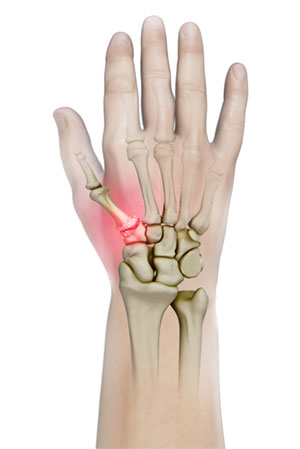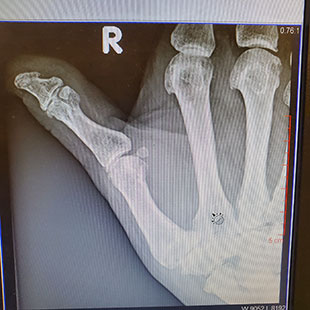What is Arthritis of the Thumb?
Arthritis is an inflammatory condition of the joints. There are several types of arthritis. The most common type is osteoarthritis or wear-and-tear arthritis that affects the joint at the base of the thumb. Thumb arthritis is more common in women than men, and usually occurs after the age of 40 years.
Symptoms of Arthritis of the Thumb

The symptoms of arthritis of the thumb usually include swelling, pain, stiffness and malformation, all of which interfere with the use of the hand. Patients often describe difficulty with pinching, opening jars and turning door knobs. Loss of steength due to pain is a common complaint.
Diagnosis of Arthritis of the Thumb

Your doctor can usually make the diagnosis of thumb arthritis by examining the thumb. X-rays of the joint may be ordered to determine the severity of the disease, and identify any bone spurs or calcium deposits.
Treatment for Arthritis of the Thumb
Non-surgical treatment methods for relieving pain in an arthritic joint include activity modification, pain medications, and use of splints and ultrasound guided steroid injections. Surgery is usually considered when non-surgical treatment fails to give relief. There are different surgical procedures that can be used:
- Synovectomy: This surgery is usually indicated for early cases of inflammatory arthritis where there is significant swelling (synovitis) that is causing pain or is limiting the range of motion of your digits and thumb. Synovectomy is a surgical removal of the inflamed synovium (tissue lining the joint). The procedure may be performed using arthroscopy.
- Arthroplasty: In this procedure, Dr. Miller removes the trapezium, thereby eliminating the source of your pain. The thumb is then stabilized using an extra tendon from the wrist area. the excess tendon is placed in the space left to act as a spacer. This procedure, otherwise known as a ligament reconstruction tendon interposition (LRTI), provides significant pain relief while maintaining excellent function. This is one of the most common procedures that Dr. Miller performs. The outcomes are excellent and therefore this is his preferred method of dealing with advanced basal thumb arthritis.
- Arthrodesis: A fusion, also called an arthrodesis, involves the removal of the joints and fusing the bones of the joint together using metal wires or screws. Even though this surgery eliminates all motion at the base of the thumb, the resulting fusion is very hard. This procedure is rarely indicated given the excellent outcomes with the LRTI procedure. Historically, it was reserved for manual laborers.
Dr. Miller will discuss the options and help you decide which type of surgery is the most appropriate for you.
Rehabilitation following Surgery for Arthritis
Following surgery, a rehabilitation program, often involving a Certified Hand Therapist (CHT), may help to regain hand strength and movement. You may need to use a postoperative splint for a while after surgery to help protect the hand while it heals. You may need to restrict activities for a minimum of 12 weeks to let the joint reconstruction heal properly. Although recovery is slow, you should be able to resume your normal activities within a few months of surgery. During this time your fingers are free to use as tolerated while the thumb is protected. You can expect the thumb to improve for up to a year, although most of the pain relief is experienced in the first few months.















